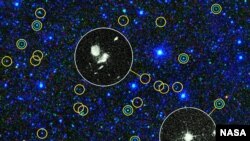NASA's Wide-Field Infrared Survey Explorer telescope, also known as WISE, has led to a bonanza discovery of supermassive black holes and rare galaxies called hot DOGS, or dust-obscured galaxies.
WISE scanned the sky twice in infrared light, completing its survey early last year. NASA released all of the data from the mission, allowing scientists around the world to continue to make new discoveries of their own.
Using WISE, astronomers have identified some 2.5 million actively feeding supermassive black holes, some of them more than 10 billion light years away. About two-thirds of these black holes previously were unknown. A black hole is an object whose gravitational pull is so strong that nothing, not even light, can escape it once inside a particular region.
NASA astronomer Daniel Stern says the latest findings are helping astronomers better understand how galaxies, and the black holes at their centers, grow and evolve together.
"One of the biggest results in the past decade has been a realization that every galaxy appears to have a large black hole at its center. Our own Milky Way [galaxy] has a black hole weighing about 4 million times the mass of the sun [our sun]," said Stern.
WISE researchers also report finding the rarest and brightest galaxies known. WISE project scientist Peter Eisenhardt says these are called "hot DOGS" because they are very hot, dust-obscured galaxies.
"And now, with the WISE survey in hand, we are finding that is actually the most obscured objects in the WISE sky that are among the brightest in the universe. WISE has found about 1,000 of these brilliant "hot DOGS," said Eisenhardt.
Eisenhardt says these galaxies are the brightest because they are the most powerful, emitting the most energy across the electromagnetic spectrum, even though they might not be easily visible. Experts say these galaxies are more than twice as hot as other infrared-bright galaxies and that they might be seeing a new, rare phase in the evolution of galaxies - another clue in understanding the mysteries of the universe.
WISE scanned the sky twice in infrared light, completing its survey early last year. NASA released all of the data from the mission, allowing scientists around the world to continue to make new discoveries of their own.
Using WISE, astronomers have identified some 2.5 million actively feeding supermassive black holes, some of them more than 10 billion light years away. About two-thirds of these black holes previously were unknown. A black hole is an object whose gravitational pull is so strong that nothing, not even light, can escape it once inside a particular region.
NASA astronomer Daniel Stern says the latest findings are helping astronomers better understand how galaxies, and the black holes at their centers, grow and evolve together.
"One of the biggest results in the past decade has been a realization that every galaxy appears to have a large black hole at its center. Our own Milky Way [galaxy] has a black hole weighing about 4 million times the mass of the sun [our sun]," said Stern.
WISE researchers also report finding the rarest and brightest galaxies known. WISE project scientist Peter Eisenhardt says these are called "hot DOGS" because they are very hot, dust-obscured galaxies.
"And now, with the WISE survey in hand, we are finding that is actually the most obscured objects in the WISE sky that are among the brightest in the universe. WISE has found about 1,000 of these brilliant "hot DOGS," said Eisenhardt.
Eisenhardt says these galaxies are the brightest because they are the most powerful, emitting the most energy across the electromagnetic spectrum, even though they might not be easily visible. Experts say these galaxies are more than twice as hot as other infrared-bright galaxies and that they might be seeing a new, rare phase in the evolution of galaxies - another clue in understanding the mysteries of the universe.








